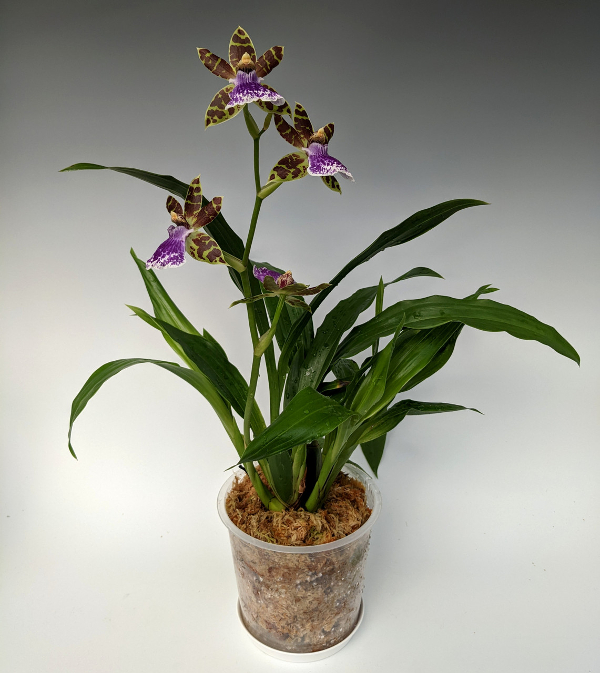
Shop for Zygopetalum & Other orchids
The genus Zygopetalum has been made popular by their ease of growth and extremely fragrant flowers, which tend to smell of hyacinth or black pepper. You will commonly see "mericlones" as they are very easy to clone and produce high quality and quantity plants. These orchids tend to flower in the fall and spring. In order to initiate the flower spikes, it is important to grow the plant in an area where the night temperatures fall below 65°F (18°C).
Light and Shade
We have found that Zygopetalum grow well under a rather low amount of light (1500 to 2000 foot-candles), so that if a hand is passed over the leaves it does not produce a shadow. We recommend growing in east or west-facing windows. South-facing windows should only be used if shielded from the sun using a sheer curtain. If temperature highs remain below these orchid's limits, then Zygopetalum can be grown outside from June to late fall in areas with filtered light, such as through a pine tree or shrub in early morning or afternoon. Be careful not to exposure these orchids to prolonged direct sunlight, as the leaves may sunburn easily. If using artificial light to grow indoors, LEDs are the best option. The artificial light market has expanded greatly in recent years, so a quick Google search will result in a variety of lighting options and price ranges.
Temperature and Humidity
Zygopetalum do well in the average home or a cool to intermediate temperature greenhouse. These orchids prefer daytime temperatures from 70°F to 75°F (21°C to 24°C), and night temperatures between 58°F to 62°F (14°C to 17°C). If you keep your Zygopetalum watered well, humidity will not be a critical factor in their growth. However, these orchids thrive under high humidity and will benefit from humidity levels above 50%. This can be achieved at home with the use of a humidifier or a humidity tray. Just make sure that the plant is not standing in water or the roots will rot.
Feeding
We highly recommend Green Jungle Orchid Food, specially formulated to provide orchids with the nutrients they would naturally encounter in their wild habitats. This is the fertilizer that we developed to use on our own plants in production, with excellent results for decades! This formula works best with water low in alkalinity (such as rainwater, distilled water, or reverse osmosis water). However, you may use tap water, keeping in mind that mineral buildup will require repotting more frequently, on the order of every 1 to 2 years.
If potting in bark mix, fertilize every time you water, flushing with non-softened water once a month. This rinses the media of salt and mineral buildup. When potting in sphagnum moss, fertilize every 3rd watering year round.
Watering
Zygopetalum like to be kept fairly moist, with the media just approaching dryness between waterings. During warm dry weather, they may need to be watered 2 to 3 times a week. Zygopetalum are large-leaved orchids that transpire a relatively high volume of water. These orchids form wrinkled, accordion-like pleated leaves when not receiving enough water. If this happens, check the root system. Over-watering may have caused the roots to rot, thereby depriving the plant from absorbing water. If the roots are healthy, you are likely under-watering and should increase your watering schedule accordingly.
We always recommend watering in the morning, as this gives the leaves time to dry and avoid bacterial growth overnight. If possible, use water low in alkalinity, such as rainwater, distilled water, or reverse osmosis water. If you have a dehumidifier in your home, the water that collects in the tray is excellent for watering orchids.
Potting
Zygopetalum do well in a light, porous medium, capable of holding moisture while draining thoroughly upon watering. At Orchids Limited, we recommend potting these plants in New Zealand Sphagnum Moss, the Medium grade of our Traditional Orchid Bark Mix, or our Modern Moisture Retentive Mix (contains rockwool).
These orchids tend to be less finicky than other orchid groups, so you may allow room for up to two year's new growth. Repot once every 1 to 2 years, preferably in the spring when active growth resumes. When repotting, choose a pot that is large enough to accommodate 1 or 2 years growth (2 to 3 new bulbs per year). Grab the plant near the base of the pot and start by gently, but firmly, pulling the plant out of its old pot. If the mix is old, crumbly and sour, carefully remove the media and rinse the root system. Trim off any dead roots and dead bulbs. Position the plant with its oldest bulbs to the edge of the new pot. Then, spreading the plant roots out, fill in the space with the potting medium.
Zygopetalum can be divided when there are 6 or more pseudobulbs. Should you wish to divide your plant at this time, each section should have three or four green bulbs in addition to any new leads. Old leafless pseudobulbs should be removed if the procedure will cause no damage to the rest of the plant. You can watch our video on dividing orchids here.
To avoid the transfer of orchid diseases, it is standard procedure to sterilize all cutting and potting instruments before using them on a plant. This can be done by flaming pruning shears with a butane torch, or by spraying with rubbing alcohol and wiping with a clean paper towel.
Shop for Zygopetalum & Other orchids
